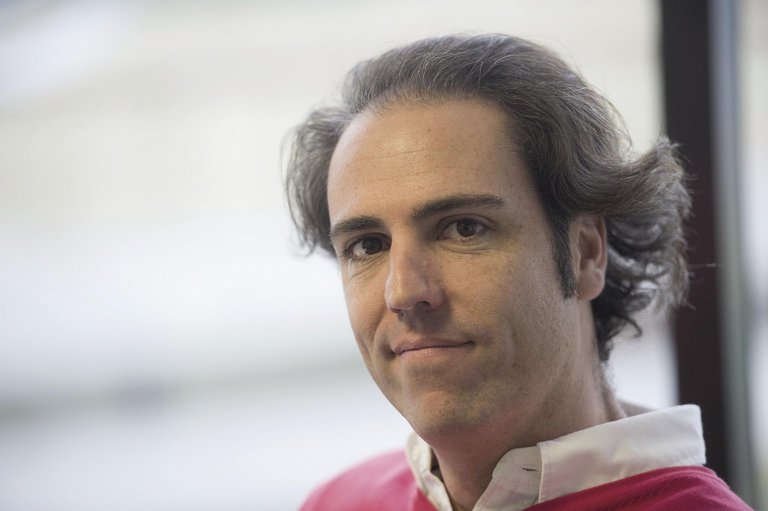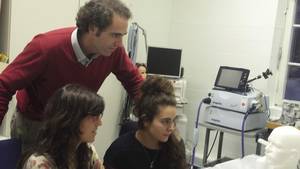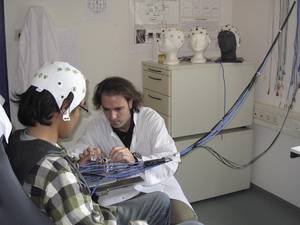“It’s important to do things fast, but it’s more important to do it well.”

The truth is that yes. In one year it is scientific and in the next it is of letters, so every two years it is of sciences, so it is not easy. In addition, within the sciences, ours is not a conventional discipline, it is not chemistry, physics or biology, but perhaps for that reason they have rewarded it for being interdisciplinary.
However, for me it has been a surprise. Apparently, to receive the prize, someone has to name you before and I did not know that he was appointed. So at first I was surprised. Now, however, I am happy because thanks to the impact that the prize has had, many people have known our work, especially there [Euskal Herria].
No, I don't think. It is above all a personal recognition and it affects me in my motivation. It's an impulse, it indicates you're doing things right, but I don't think it has another consequence. It is another step in my research career that I hope will be long.
In Germany I have been nine years, but it was about twelve. Studying Industrial Engineering I went to Austria with an Erasmus grant, from there to Munich and studied Medical Engineering in Munich. Then it was not a master's degree, it was a three-year degree: it had to have spent a year and a half studying subjects, but if it was very fast it could have done so in a year. That's what I did. And then I had to do the practice, at least for three months, but I did two practices, six months, because otherwise nothing can be learned. And I went to study.
Thus, I did the first course of medicine almost entirely and then did the practices in a functional electrical stimulation clinic. It consists in stimulating the muscles by electric discharge, as do the devices that advertise on television. Well, this stimulation is also used in paraplegics, since it also favors the joints. And there was a Hungarian doctor, an engineer and a doctor, and I started to help him. We got the paraplegics to ride a bike and remember that a patient had a visor of Euskaltel. It was also an international career of patients who used this technology, take the accounts.
I also worked in operating room practices with prostheses, physiological tests and in industry at the German Space Agency. There I made a robotic model of cardiac movement. And I realized that I liked neuroprostheses. I thought I should be able to somehow control the electrical stimulation of the muscles, and I realized that in the presentation of researchers from the United States were working on it. So I decided to go there.
Yes, I went to Johns Hopkins Hospital, Baltimore, a laboratory for brain-computer interfaces. There I studied a lot of very good researchers. I had to work hard to work at their level and realized that I dominated the technical part, but I had gaps in neuroscience. So I decided to have a doctorate in neuroscience.
I started looking for a doctorate site and in Germany I found Niels Birbaumer. He is the father of the brain-machine interfaces and when I told him what I wanted to do, he said: “You’re a bit crazy, but I like your idea and I like people who are crazy like me. However, you will not be able to do it alone.” And I was right, I couldn't do it alone, so I looked for scholarships and funding, collected researchers and students and launched the project. And in part for this project I have been awarded the prize.
Our goal is to help patients with cerebral infarction regain movement. Once cerebral infarction is known, it is very important to go to the health center as soon as possible. In this sense, in Biodonostia, for example, a very good job is being done, thanks to which more and more people know that, in case of loss of some function, it is very important to go to the hospital as soon as possible, since the loss may be due to a cerebral infarction or stroke. For example, if you can't talk suddenly and have a lot of headache, it is advisable to go to the hospital right away without waiting for it to disappear by itself. If not, by the time you go, the damage is much greater.
During the first six months after going to the hospital, it may happen to recover without more, since the brain is very plastic. We wait until then and address the worst cases, that is, those who, after six months, continue with mobility problems and, above all, with total or almost lost mobility. These patients cannot perform conventional rehabilitations, so they could not receive treatment until now.
We have shown that electromyography can be used in 40% of patients. With this we take advantage of the residual muscle activity to achieve movement. And in the rest of the cases we use brain-machine interfaces to regenerate the cerebro-muscle connections.
Yes, we are the first to show that some of the chronic patients with great paralysis maintain a small residual muscle activity. The detection of this residual activity is not easy and so far no one thought it could be used. But we have shown that yes, which is possible, in 40% of cases. We have developed algorithms to see what movement you are trying to make. It is not very precise at the moment, but we are advancing.
On the one hand it is simpler and on the other it is easier. In the interfaces we must decode the signal generated by the brain, while in the electromyography we start from the muscle signal.
However, in some cases we have difficulties. There are patients who control the muscles very little, but control them badly. For example, they want to move the arm and know what the signal is to move the arm, but the signal gets wrong because the path has been cut and wrong. This is called defective muscle synergy. This can cause, for example, you want to stretch your arm to catch an apple, but instead of stretching it, fold and approach your body.

In these cases, if you put the electrodes in the muscle to receive the signal, you will be wrong, since muscle activity does not correspond to the brain order. Therefore, we must be careful and take into account the two things: the order of the brain and muscle activity.
In the end, what we do is offer these patients the opportunity to test new therapies and see what is most suitable for each person.
Well, in that we try. The movement we get is very small, millimetric. But the step, from paralysis to moving something, is very big. But we still do not have the function recovery.
With this aim, we have started a collaboration between Biodonostia, the hospital of Donostia, Tecnalia, the UPV and the University of Tübingen. Among other things, we want to improve the brain signal collection system. We now use electrodes placed in the skull, such as recording sounds from inside the house with a microphone located outside. We will hear much better if we put the microphone inside the house, so with almost non-invasive surgery it is intended to place some tiny electrodes on the surface of the brain.
Tests have already been done on primates and in some people, and it has been proven that these electrodes record the activity of the brain with total precision. This allows us to receive more degrees of movement, to move or not was what we received before, and now move more or less, in two or three dimensions, arm or hand...
The project is very advanced, we have worked a lot to get here, and now we want to continue advancing and testing. To do this, we are gathering specialists and researchers from San Sebastian, which has a great influx of people, which in turn gets sponsors and funding.
I do not know when it will be because we do not start to ensure that all aspects are well related and that we have all the guarantee. In these accounts it should be prudent. It is important to do things fast, but it is more important to do it well.
This form of work requires time, patience, and in that sense I have to thank Tecnalia, because I have been accompanying from the beginning and throughout my entire career and still help me.
Buletina
Bidali zure helbide elektronikoa eta jaso asteroko buletina zure sarrera-ontzian












